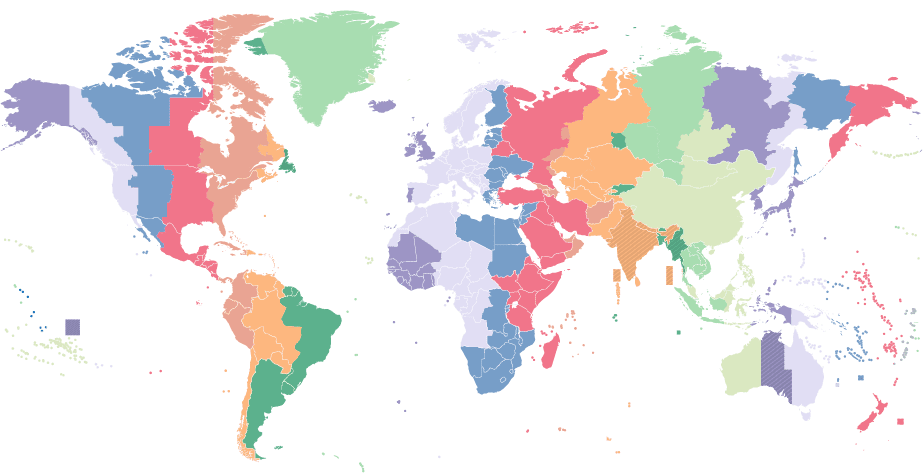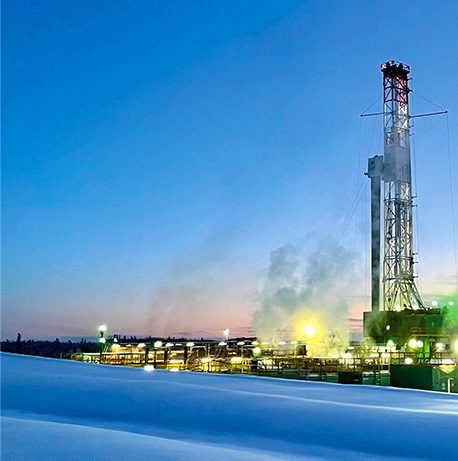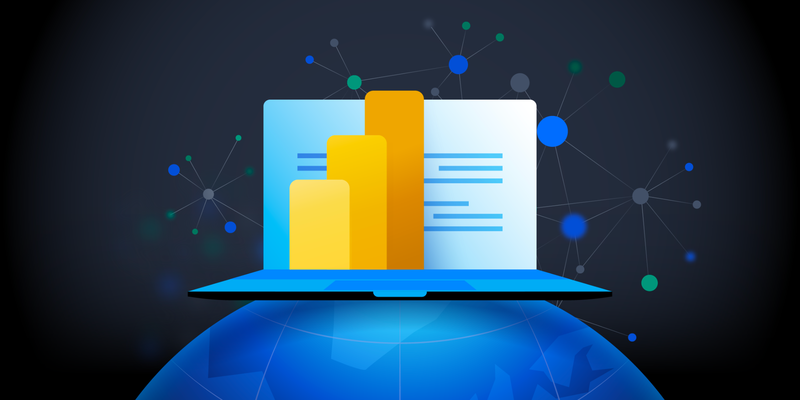The Demand for Data Visualization Developers Continues to Rise
Data visualization development has evolved from a niche technical skill into a cornerstone of modern, data-driven decision-making. Across industries like fintech, healthcare, logistics, and SaaS, businesses increasingly rely on interactive dashboards and analytics to stay competitive, and the demand for skilled data visualization engineers continues to accelerate.
As data volumes grow and analytics environments become more complex, organizations of all sizes—from startups to established enterprises—need visualization experts to engineer intuitive, interactive experiences. In 2024, the data visualization market was valued at $4.2 billion and is projected to reach $8.2 billion by 2033, expanding at a compounded annual growth rate of 7.38%. Organizations are investing heavily in developers who can turn raw data into accessible and impactful visual stories.
As demand surges, hiring has become increasingly competitive. Skilled data visualization developers blend technical fluency, creative storytelling, and strategic thinking to fundamentally elevate how businesses understand, communicate, and act on their data. This guide walks through the process of finding the right expert who can transform your complex business information into insight—and insight into measurable business impact.
What Attributes Distinguish Quality Data Visualization Developers From Others?
Top-tier data visualization engineers offer far more than basic charting skills. They combine a deep understanding of data structures with front-end design sensibilities to build dashboards, reports, and visual experiences that align directly with your business goals. These professionals thrive in collaborative environments, communicate effectively across teams, and deliver clean, scalable, and insight-driven visual products.
The best data visualization developers are self-driven and deadline-conscious. They manage their own timelines, surface blockers early, and stay aligned with stakeholders throughout the process. They must also be skilled communicators who can explain technical decisions, ask the right questions, and translate data into visual formats that resonate with diverse business audiences.
Technically, strong candidates are fluent in libraries like D3.js, Chart.js, and Highcharts, and often have front-end experience with frameworks like React or Vue. Many are also proficient in platforms like Tableau, Power BI, and Looker (including Looker Studio). For data-intensive roles, comfort with tools like SQL, Python (especially Pandas and Plotly), or R is frequently expected.
Importantly, top developers understand the analytical foundation behind the visuals they build. Whether wrangling SQL queries, identifying trends in Python, or validating assumptions with analysts, great visualization work is grounded in analytical thinking, not just aesthetics.
In addition to technical and analytical capabilities, soft skills matter. The most effective visualization professionals demonstrate adaptability, curiosity, and a willingness to iterate. Familiarity with collaboration tools like Slack, Trello, Jira, Figma, and Git is standard, especially in Agile team environments. These experts actively seek feedback and refine their solutions based on business needs.
Complementary Technology Skills for Data Visualization Developers
In the current tech landscape, the most valuable data visualization specialists bring a mix of core and complementary skills. Here are some capabilities that set top candidates apart:
Front-end Development: Fluency in HTML, CSS, JavaScript, and modern frameworks like React empowers developers to build fully interactive and responsive dashboards that deliver intuitive user experiences across devices. A strong front-end foundation enables visualization developers to embed custom visuals into products, support real-time data updates, and implement dynamic features like filters, drill-downs, and interactive storytelling elements.
Data Wrangling and Transformation: A strong working knowledge of Python (especially libraries like Pandas), SQL, or R is critical for preparing and structuring raw datasets before visualization. Skilled programmers can identify inconsistencies, merge disparate data sources, and engineer datasets optimized for performance and clarity, ensuring the final visuals are accurate and actionable.
Business Intelligence (BI) Platform Expertise: Proficiency in enterprise business intelligence platforms like Tableau, Power BI, Looker, and Looker Studio enables developers to design and deploy scalable dashboards for internal or external audiences. Familiarity with BI best practices—such as parameterized filters, calculated fields, and row-level security—ensures that solutions are efficient and compliant with enterprise standards.
Cloud and Big Data Tools: Experience working with cloud platforms such as AWS (Redshift, QuickSight), Google Cloud (BigQuery, Looker Studio), or Snowflake enables developers to interact with distributed, large-scale datasets efficiently. Developers with cloud expertise are able to build scalable pipelines, leverage serverless architecture, and optimize performance for visualizations that pull from millions (or even billions) of records without lag.
Automated Reporting: Top visualization developers can build automated pipelines that deliver up-to-date visuals through APIs, scheduled scripts, or embedded reporting tools. Automation reduces manual work, lowers the risk of errors, and ensures that decision-makers always have access to the freshest insights, even in fast-moving industries.
Security and Compliance: Developers must be familiar with privacy regulations like GDPR, HIPAA, and CCPA, and know how to implement security practices such as data masking, anonymization, role-based access control, and encryption. Protecting sensitive information in visualizations is critical, especially when dealing with financial, healthcare, or personally identifiable data.
Data Visualization Tools: Mastery of specialized libraries and platforms such as D3.js, Chart.js, Highcharts, and Plotly is essential. Familiarity with declarative visualization grammars like Vega-Lite, as well as experience with the aforementioned BI platforms, enables developers to select the right tools for different project needs—balancing efficiency, flexibility, and visual impact.
How Can You Identify the Ideal Data Visualization Developer for Your Project?
Hiring the right data visualization developer means finding someone who blends design intuition with technical depth and business understanding. This person should translate high-level business questions into data-driven visual outputs that guide action.
Define Priorities and Expertise Requirements
Start by defining your priorities: Do you need executive dashboards, internal analytics tools, embedded product visuals, or customer-facing reports? Each use case has its nuances that influence the technical skills and visualization strategies required. A developer with strong D3.js skills may be perfect for web-based interactivity, while someone experienced in Tableau might shine in enterprise reporting contexts.
After defining your primary use case, look for candidates with relevant domain experience. Have they worked with similar data sets? Do they understand your industry’s metrics and user types? Developers with a track record of remote collaboration and visual storytelling are often well-positioned to succeed in diverse team setups.
Determine the Right Experience Level
Once you’ve defined your needs, consider the level of experience required for the project. Different skill levels bring distinct strengths, and aligning the developer’s expertise with the project’s complexity can make the difference between a good solution and a great one.
Junior developers are often a good fit for implementing static dashboards, building templated visualizations, or supporting larger development teams. However, for strategic projects, senior data visualization professionals—typically with five to seven years of experience—bring broader strategic thinking, deeper problem-solving skills, and stronger cross-platform expertise. These experienced professionals can help shape data strategies by collaborating directly with analysts, product managers, and executives to ensure that visual outputs align closely with business objectives.
Regardless of years of experience, strong communication skills are essential. Exceptional developers ask insightful questions, propose creative solutions, and ensure every visualization directly supports a business objective.
How to Write a Data Visualization Developer Job Description
An effective job description will attract skilled, aligned candidates while filtering out those who don’t meet your needs. Use a clear, specific title such as “Data Visualization Developer (React, D3.js)” or “Tableau Developer for Dashboard Optimization.”
Start with a brief overview of your project, such as building KPI dashboards or integrating visual analytics into a SaaS platform. Include expected timelines, team size, and whether the role is freelance, full-time, part-time, or long-term.
Next, outline the essential skills—like JavaScript visualization libraries, Tableau or Power BI, or SQL—plus nice-to-haves, such as React, Python, or experience with cloud data tools. Mention your communication style (e.g., weekly check-ins, async updates), any time zone preferences, and the platforms your team uses (Notion, GitHub, Slack, etc.).
End with a strong call to action that encourages candidates to share dashboards, GitHub repositories, case studies, or portfolio links. Be clear about your hiring and onboarding processes so expectations are set from the start.
What Are the Most Important Data Visualization Developer Interview Questions?
Vetting a data visualization expert means going beyond technical proficiency. You’re looking for visual thinking, business acumen, adaptability, and strong communication. Ask the following questions to assess how candidates operate in real-world environments, where they must handle messy data, shifting goals, and complex, cross-functional collaboration.
Have you built dashboards or visuals for business users before?
Strong candidates will share examples of collaborations with stakeholders like product managers, analysts, or executives to deliver visualizations that drive real decisions. Look for signs of iterative design, responsiveness to feedback, and a clear understanding of how the visualizations were used in a business context. Bonus points if they can quantify the impact in terms of faster insights, improved reporting, or better user engagement.
How do you manage multiple visualization projects or requests?
They should be able to explain how they prioritize tasks, manage deadlines, and keep projects moving across multiple stakeholders or competing priorities. Expect references to tools like Jira, Trello, or Notion, as well as a clear process for balancing technical work with business needs. The best candidates demonstrate strong time management and an ability to deliver high-quality work without compromising clarity or accuracy.
Can you walk us through a dashboard you developed from start to finish?
Ask them to explain the business challenge, the audience, the tools and data used, and how the final dashboard met the goal. Listen for thoughtful design decisions, interactivity, responsiveness, and performance optimization. Top candidates will show technical depth, user-centered thinking, and evidence of how their work uncovered trends and informed business action.
How do you approach evolving requirements or unclear KPIs?
Data visualization developers often work in fast-changing environments. The best ones are proactive about clarifying goals early, building flexible solutions, and staying close to stakeholders throughout the process. They should explain how they manage shifting priorities while keeping visuals relevant, usable, and aligned with business outcomes.
What do you do when the data is messy or incomplete?
High-quality developers know how to resolve issues when source data hasn’t been cleaned and structured ahead of time. They should be able to leverage SQL, Python, R, or platform-specific tools to reshape data, identify gaps, and communicate data issues back to the business. They should be skilled in validating sources, flagging inconsistencies, and building dashboards that reflect reality, even if that means showing incomplete data transparently.
How do you test and validate your visualizations?
Solid answers should include performance testing, user feedback, accessibility checks, and cross-device and cross-browser validation. Top developers will also mention tools for version control, stakeholder reviews, and documentation. They should describe a clear, repeatable process that ensures accurate, user-friendly, and production-ready visualizations.
Why Do Companies Hire Data Visualization Developers?
As organizations become more data-driven, the ability to turn raw data into clear, actionable visuals becomes a competitive advantage. Companies hire data visualization engineers to accelerate decision-making, enable self-serve analytics, and communicate insights at every level, from internal ops to executive leadership to customer-facing platforms.
These developers help teams understand KPIs in real-time, spot trends early, and unlock deeper value from existing data. By supporting everything from strategic planning to product analytics and operational oversight, data visualization developers help decision-makers understand—and act on—the data that drives business growth.


























